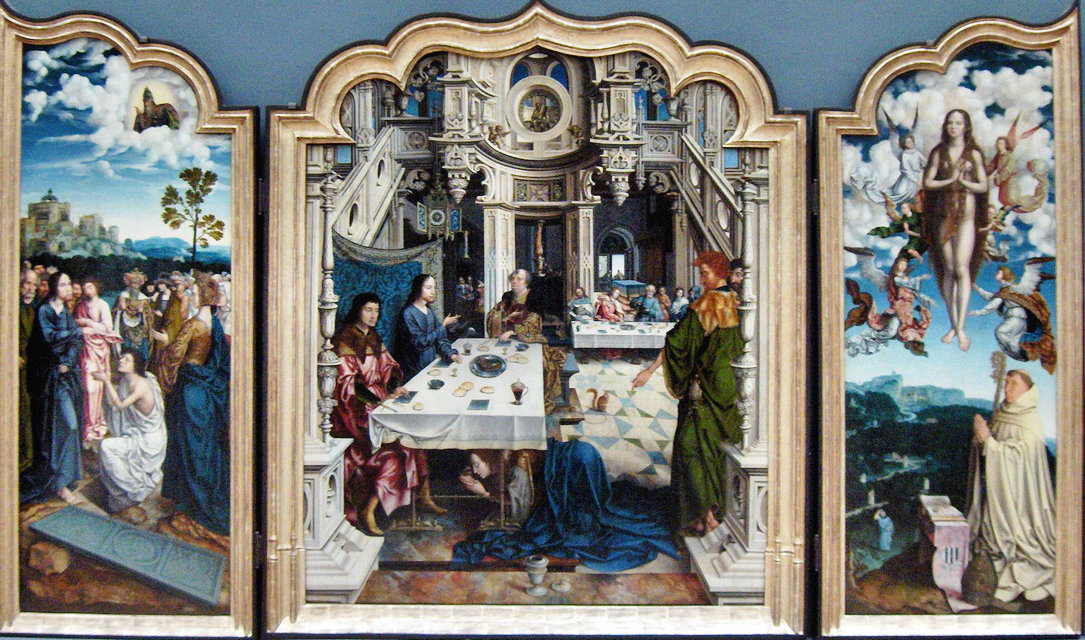Antwerp Mannerism is the name given to the style of a group of largely anonymous painters active in the Southern Netherlands and principally in Antwerp in the beginning of the 16th century. The style bore no relation to Renaissance or Italian Mannerism, but the name suggests a peculiarity that was a reaction to the “classic” style of the earlier Flemish painters.
Antwerp Mannerism is the name given to the style of a large group of painters, largely anonymous, from Antwerp at the beginning of the 16th century. The style had no direct relation to the Renaissance or Italian Mannerism, but the name suggests a peculiarity that was a reaction to the “classical” style of the early Flemish painters.Although attempts have been made to identify individual artists, most of the paintings are still attributed to anonymous teachers. The characteristics of the mannerism of Antwerp are attributed to Jan de Beer and Jan Wellens de Cock, that of the Master of 1518 (possibly Jan Mertens van Dornicke or Jan van Dornicke), as well as those of the Pseudo-Blesius and some early paintings by Jan Gossaert and Adriaen Isenbrandt. The paintings combine primitive Dutch and Nordic Renaissance styles, and incorporate both Flemish and Italian traditions in the same compositions. Among those who practice the style, they often painted subjects such as the Adoration of the Magi and the Nativity, both generally represented as nocturnal scenes, populated with figures and illuminated in a dramatic way. The scenes of Adoration were especially popular among the Antwerp Mannerists, who delighted in the prints of the elaborate clothes worn by the Magi and the ornamentation of the architectural ruins in which the scene is set.
The next wave of influence of Italian painting came with Romanism, as seen in Gossaert’s later works.
The term Antwerp Manierists’ was first used in 1915 by Max Jakob Friedländer in his work Die Antwerpener Manieristen von 1520, in which he made a first attempt to put order in the growing number of works from the Netherlands that were catalogued under the ‘name of embarrassment ‘pseudo-Herri met de Bles’. Friedländer used the term Antwerp Mannerism here as synonymous for “Antwerp style”. Even though he added the location ‘Antwerp’ to name the artists and placed them in the year 1520, Friedländer made it clear that he did not intend to limit the group strictly to Antwerp and the time period to circae 1520, even though he was of the opinion that most of the “pseudo-Bles’ works originated from Antwerp and Antwerp workshops. Friedländer placed the works attributed to the group in a time period between 1500 and 1530.
Despite the name Antwerp Mannerism the style was not limited to Antwerp. The style also appeared in the north of France and the Northern Netherlands.
Artists
Although attempts have been made to identify the individual artists that were part of this movement, most of the paintings remain attributed to anonymous masters as the paintings were not signed. This anonymity has contributed to a lack of knowledge about or popularity of their works. Only a minority of the works have been classified. The makers of the altarpieces have been given notnames based on any external knowledge about the works such as an inscription, a previous owner, the place where it was kept or a date found on the work. Th of Pseudo-Bles, the Master of the Von Groote Adoration, the Master of Amiens, the Antwerp Master of the Adoration and the Master of 1518. Works that cannot be attributed directly to a named master are attributed to the Anonymous Antwerp Mannerist.
It has been possible to identify some of the artists. Jan de Beer, the Master of 1518 (possibly Jan Mertens or Jan van Dornicke) are some of the identified artists who are regarded as Antwerp Mannerists. The early paintings of Jan Gossaert and Adriaen Isenbrandt also show characteristics of the style. The paintings combine Early Netherlandish and Northern Renaissance styles, and incorporate both Flemish and Italian traditions into the same compositions.
Themes and style
The Antwerp Mannerists typically depicted religious themes, which they interpreted generally in a more superficial manner than the Flemish artists of the previous century in favour of a more fluid form and an abundance of meticulously rendered details. They also show a preference for a changing palette. Their compositions are typically shock-full with agitated figures in exotic, extravagant clothes. The compositions typically include architectural ruins. The architecture is initially Gothic but later Renaissance motifs become dominant. Many of the panels or triptychs produced by the Antwerp Mannerists depicted scenes of the Nativity of Jesus, usually situated at night, the Adoration of the Magi and the Crucifixion.
The theme of the Adoration of the Magi was in particular dear to them as it allowed the artists to give free rein to their preoccupation with ornament and the simulation and imitation of luxury products. The next wave of influence from Italian painting came with Romanism, as seen in the later works of Gossaert.
From Wikipedia
Source: https://en.wikipedia.org/wiki/Antwerp_Mannerism
